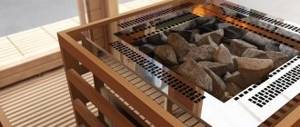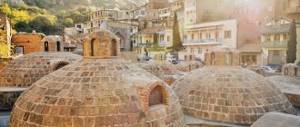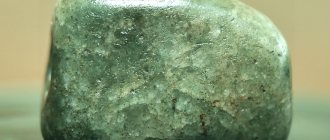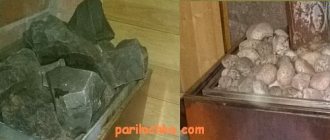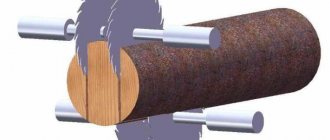Without what will a bathhouse not be a bathhouse? Brooms, hot water, stove, firewood - everything is important. But if the ruler bakes in the bathhouse, then the stones are her heart! Not every stone can perform this important function, but soapstone copes with this task perfectly.
What do we want first of all from a Russian bath? Persistent heat, light steam, optimal humidity and all these wishes directly depend on what stones are placed in the sauna stove.
Soapstone for baths: properties
This is a complex mineral in its structure, the main part of which is composed of magnesium, aluminum and silicon compounds, and there are iron and calcium salts. In soapstone chlorite, all this wealth is represented by an interweaving of thread-like and layered structures interspersed with chlorite, pure quartz and talc. The chemical formula looks like this.
The presence of silicon, aluminum and magnesium in the composition determines good heat resistance
The classic color of the mineral is usually gray, sometimes with beautiful bluish and greenish tints. It is this soapstone tile that is most often chosen for cladding walls and bathhouse stoves. In solid wood, this finish resembles marble.
Soapstone is rarely polished, but after special treatment and impregnation it can easily be confused with marble
Often they try to paint polished soapstone slabs, trying to pass them off as more expensive jadeite and jade. This option can be implemented for individual fakes and carved decorations on the fireplace, but it is clearly not suitable for the interior decoration of a bathhouse.
The most interesting properties of soapstone for using stone in bath decoration:
- Due to inclusions of talc, the mineral turned out to be quite soft, its hardness ranges from 1 to 5.5 Mohs units. Therefore, during the preparation process, soapstone tiles for a bath are easy to cut and adjust to the required size;
- Relative chemical inertness, the lining of the stove and bathhouse walls, even with direct contact of the tiles with hot metal or an open flame, does not emit any harmful or toxic compounds;
- High melting point. To destroy soapstone chlorite, the tile must be heated to 1640°C, which is much more than the metal and brick base of the oven can withstand. For a bathhouse, this is also a good way to protect wooden floors and walls from the hot parts of the firebox and heater;
- The heat capacity of soapstone chlorite is 0.98 kJ/kgC, which means that the tile lining can give off heat for a long time, effectively drying the bathhouse from accumulated water and condensate;
- High thermal conductivity, on average 5-6 W/mC, which is 5-7 times more than that of solid red brick, and an order of magnitude less than that of cast iron and stainless steel.
It was the successful value of thermal conductivity that caused the growing popularity of soapstone chlorite. Lining the steel walls of the furnace with soapstone tiles provides the most comfortable level of heat dissipation. As a result, the sauna stove turns out to be quite economical, since the heat does not escape into the chimney with the products of burning wood, and at the same time powerful, but not scalding.
The firebox lining guarantees safe operation of the stove in the bathhouse
Important! Another property has become the reason for the active use of soapstone in finishing bathhouse stoves. This is a low rate of thermal expansion, its value does not exceed 0.001% for each degree of heating.
This means that the tiles will not crack or peel off on the surface of the oven during high heat or even during thermal shock - pouring boiling water over a hot mineral.
Cons of the stone
Soapstone is a heavy stone, so the furnace needs a solid foundation. It takes a long time to heat up, therefore, heating the stove will require more wood and time.
The appearance of the stones is gloomy. If you want to get aesthetic pleasure from contemplating stones in an open stone backfill, soapstone will not fulfill this task.
The cost of the stone is slightly higher than that of its competitors. For example, crimson quartzite costs a little more. Perhaps the price of stones varies depending on the region of our country. Therefore, it would not be entirely correct to consider this a minus.
Any minus can be made a plus. A solid foundation is the key to a long service life of the stove; it will not settle or crack.
The longer the stones heat up, the longer they then give off their heat. For example, my bathhouse is warm the next day.
It is not a pity to load soapstone into a closed backfill; its gloominess will not confuse anyone.
Advantages and disadvantages of soapstone
The attitude of lovers of strong steam towards the use of minerals in the bath is twofold. On the one hand, soapstone has established itself as a practical and easy-to-use material, especially for modern metal furnaces. On the other hand, there are certain nuances in using soapstone that need to be taken into account before covering the floor and walls with the mineral. You can, of course, judge the advantages and disadvantages of soapstone for baths based on reviews, but it would be useful to get acquainted with the positive and negative sides from the practice of using the material.
Advantages of using the mineral
Soapstone really has a lot of positive qualities. For example, tiles are often used to cover the floor and shelves in a steam room; it is believed that in this way one can effectively warm up and treat radiculitis and inflammation of the back muscles.
A floor lined with soapstone tiles is not slippery, and moderately high thermal conductivity makes it possible to effectively use heating with an electric cable, both in the dressing room and in the washing compartment.
If soapstone tiles and torn stone are used to decorate the walls of the bathhouse, then the atmosphere inside such a room is considered lighter and more pleasant to breathe, even at a high level of humidity. There is no scientific explanation for this, but, according to some reviews, bath stones made of soapstone make the steam not as hot as when using a quartzite heater backfill.
Another significant advantage is that soapstone lining is easy to wash and clean, even if the so-called soapstone in the form of torn stone is used. Sanded and smooth material can generally be washed in a bathhouse using a high-pressure manual car wash, and neither the color of the tile nor the reliability of its fastening to the stove or floor is affected.
Disadvantages of using soapstone tiles
In open sources you can find a lot of negativity about the mineral. Experts often claim that when heated, tiles can emit sulfur dioxide or very light and therefore volatile microdust, which has a strong irritating effect.
Important! The first claim is true for tiles made of low-grade mineral. If inclusions and veins of a golden-yellow or greenish hue are observed in the stones, then it is better to avoid using the material.
The only serious drawback of soapstone tiles is the low hardness of the mineral. This means that the material wears out quickly under abrasive load. In a private bathhouse, the tiles on the floor will withstand at least 7-8 years of use; the flooring in public bathhouses and the stones in the backfill must be changed every three years.
Some interesting facts about soapstone
I have never come across as many names for any stone as soapstone has.
People call it stove stone, soap stone, pot stone, wax stone, ice stone, fire stone and even mammoth stone! But there are not so many scientific names: steatite, soapstone, soapcarbonate.
Large deposits are located in Eastern Finland, where there are more than 100 soapstone deposits.
In Russia, the stone is mined in Karelia and the Sverdlovsk region. Soapstone was originally used in the metallurgical industry.
Use of soapstone in a bath
The mineral is used in the steam and washing sections of the bathhouse in three versions:
- For backfilling the heater;
- For lining a stove or fireplace in a bathhouse;
- Decorative material for finishing and protecting walls and floors.
The main value of soapstone is that the material, even with strong heating and constant watering with boiling water, does not burn or change size. This means that the hot steam will always be clean and odorless. Few people pay attention to the second quality, but it may be even more important than the first. The constant size means that a pile of hot stones, even after repeated calcination, will not collapse and create a dangerous situation, as is often the case with river pebbles or gabbro.
A popular tile option with a torn surface texture
Good thermal conductivity makes soapstone tiles an ideal material for facing and lining furnaces. In addition to the fact that finishing greatly improves the appearance of a red brick stove, mineral finishing also increases the reliability of the masonry.
Many owners of steam rooms even order the interior decoration of the bathhouse with soapstone tiles. It is generally accepted that the heated stone emits soft infrared heat and is capable of treating the respiratory system and musculoskeletal system, similar to salt fireplaces and lamps. And the cladding can be very beautiful if it is done by a professional.
Areas of application
Carvings
The mineral became famous in the decorative arts. Figurines, vases, and dishes were made from it. In a number of archaeological museums, figurines of the so-called “Venus of the Paleolithic” made from it have been preserved.
The famous statue of Christ, located in Brazilian Rio de Janeiro on the top of Corcovado, is made from a mixture of soapstone and reinforced concrete.
Pans, pots, shot glasses and aromatic bowls were also often carved from this stone. It keeps you cold and keeps you warm. It is easily colored and is often passed off as a monomineral jade aggregate, although in reality it is inferior in its properties and, first of all, in strength.
Construction
Due to the ease of stone processing and its durability, the rock has found its use in the construction industry, acting as a fire-resistant material used for cladding. It has a fairly high heat capacity and good thermal conductivity, and these properties began to be used in construction in the manufacture of slabs, crushed stone and bricks. The powder obtained from the mineral can increase the heat and frost resistance of building mixtures, and crushed stone with soapstone chlorite acts as a material in the manufacture of heat-resistant concrete.
Having an external resemblance to marble, it often serves as a facing material for building facades. The properties of soapstone stone are widely used in the construction of fireplaces.
Medicine
Many lithotherapists endow soapstone with healing and magical properties, believing that this stone is capable of emitting thermal radiation similar in wavelength to radiation from the human body (8-9 microns), which has a beneficial effect on our health.
It is able to create the most comfortable conditions when generating heat, have a positive effect on the immune system and have a beneficial effect on metabolic processes.
How to choose soapstone for a bath
Firstly, you need to pay attention to the uniform color of the mineral texture on the fracture or treated surface. There should be no black, yellow or green foreign matter on the stone or tile. As a rule, these are salts of heavy metals, many of which are toxic or even poisonous.
This is a coil, a beautiful stone, but not the most harmless, it is better not to use it for a bath
This is what the best soapstone for a bath looks like, gray, with a slight touch of talc
If you select a mineral for backfilling a heater, it is best to take rolled material in the form of oval-shaped pebbles. In this case, boiling water penetrates deep into the poured layer, and accordingly, the steam release is more complete. In addition, due to the high talc content, stones with broken and torn surfaces emit dust, which is harmless, but can accumulate inside the bathhouse.
If you select tiles, then, in addition to uniform color, you need to pay attention to the absence of cracks and microchips. Most likely, such a stone was processed in violation of the cutting technology or temperature conditions.
Mineral deposits and mining
Rock mining sites are located in countries such as:
- Brazil;
- USA;
- Finland;
- India;
- Russia.
Finland is a leader in mineral extraction. The country is home to the world's largest deposit, located in Nunnalahti.
An interesting fact is that in Russia there is a large Karelian deposit, which stretches in a mountain range from Medvezhyegorsk to Finland. Mining is also carried out in the Shabrovskoye field in the Urals. Russia ranks second in the world in rock production.
Watch the video to see how the rock is mined and processed:
Soapstone tiles for baths
When laying the material, first of all, you need to pay attention to the place where the tile cladding will be laid. The density of soapstone is quite large, so it would be correct to first calculate the weight of the future finish, and only then decide how much such tiles can be used for laying on the walls of a bathhouse.
Wall and floor cladding
When decorating the interior of a bathhouse, the choice of tile size and thickness is determined by the thermal and hydraulic load. For example, the surface of wooden walls around the stove is finished with small tiles with a torn or, more often, smooth surface. The thickness of the material usually does not exceed 15-20 mm.
The same soapstone can be used to line all rooms of the bathhouse, with the exception of the washing and steam rooms. For steam rooms and sinks, large slabs are used, since there are fewer seams, which means the risk of water flowing under the cladding is reduced.
Lining furnaces with soapstone
The body of the metal furnace is finished with massive blocks, at least 40 mm thick. Since metal expands greatly when heated, there is no point in trying to attach the slabs directly to the walls. On the contrary, an air gap is left between the stove body and the soapstone casing, with a width no less than twice the thickness of the cladding.
Brick sauna stoves can be lined with pin fasteners. The process is painstaking, but quite accessible to do it yourself. The material is actually suspended on the brick, and the seams are rubbed with heat-resistant silicone.
The slabs can be easily adjusted to size manually
DIY cladding
Finishing a steel sauna stove with soapstone slabs is no more difficult than laying out a protective casing made of brick. The main difference is that the material will need to be constantly trimmed and adjusted to size using a grinder and a cutting wheel. The material is soft, so craftsmen often simply sand the desired end with regular sandpaper.
The soapstone lining is laid out on the same foundation as the stove; if there is none, then you will need to dismantle the floor of the bathhouse, pour a concrete slab and lay out the surface with large blocks.
To lay the cladding, glue based on liquid glass and finely ground soapstone powder is used. After installing the slab with glue, it must be fixed in the masonry with spring clips and spacers, which are subsequently removed, and the marks are cleaned and rubbed with glue.
Impact on the body
Reviews of soapstone for baths are mostly positive, many note its medicinal properties. In particular, it is common during hot massage; under its influence, the skin is rejuvenated and cleared of inflammation. In the assortment of stores you can find stone heating pads made from Karelian mineral; according to buyers, they are convenient for treatment at home. Also, soapstone for baths reduces blood pressure, improves immunity, has a beneficial effect on the throat and lungs, and accelerates the passage of colds.
Soapstone for baths: reviews
Vasily Alekseevich Belov, 61 years old, Vladivostok
It is better not to lay tiles on the stove with silicate glue, the seams will still crack. I assembled a steel frame around the box and attached the chalcopyrite slabs to the mesh with wire. I once laid tiles on the stove like this. The stone has been standing for two decades now. My neighbor's has already been re-laid with glue twice in the last five years.
Alexey Basnyansky, 43 years old, Ufa
The material is a bomb, but it’s better not to experiment, but to buy a ready-made set of soapstone cladding for a specific firebox model. There is no need to cut anything, everything is ready, even the corner elements and the window under the door - everything was done at the factory. True, the smell of such tiles is terrible, probably because of the paint; you need to burn it for a week to get rid of the feeling of burnt chemicals.
Recommended Posts
Bathhouse 2 by 2, 6 by 9, 3 by 4: log projects Mold
in the bathhouse: how to get rid
High-tech bathhouse, loft and chalet - designer solutions…
Bathhouse with gazebo
Lamps for the bath: for the steam room, for the dressing room, for the washing room
How to treat the outside of a log bathhouse
Description
Soapstone for baths is a rock extracted from stratal deposits, which contains chlorite, talc and magnesite. It is distinguished by a muted, matte sheen and gray color, while it may have a greenish, brown or white tint due to impurities in the composition. This stone is also called ice, wax or soap due to its absolutely smooth structure.
In ancient times, it was believed that the mineral and products based on it had magical properties. The warmth emanating from it is soft and relaxing, caused by heat waves similar in length to those of humans.
In nature, the stone is found, as a rule, in the USA, India, Finland and in some regions of Russia. The mineral was formed millions of years ago as a result of exposure to high pressure and temperatures.

